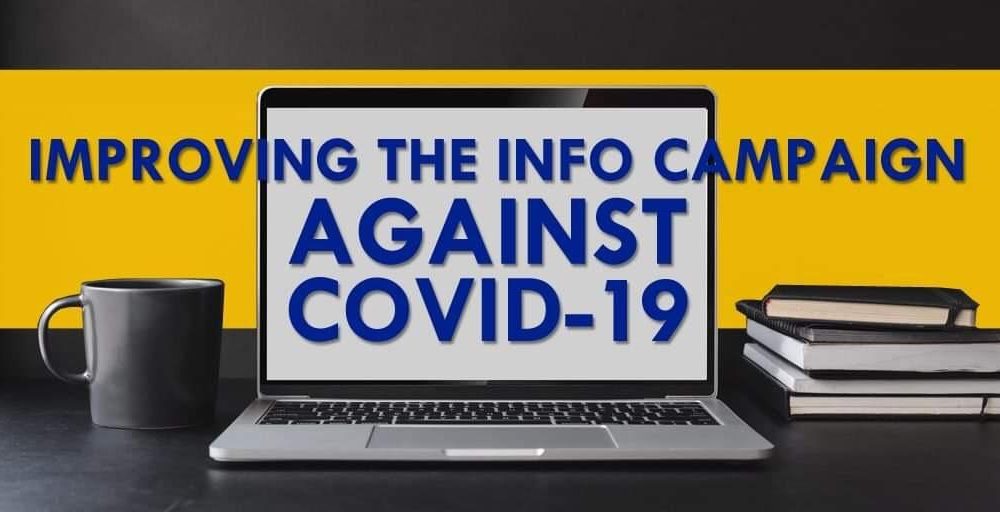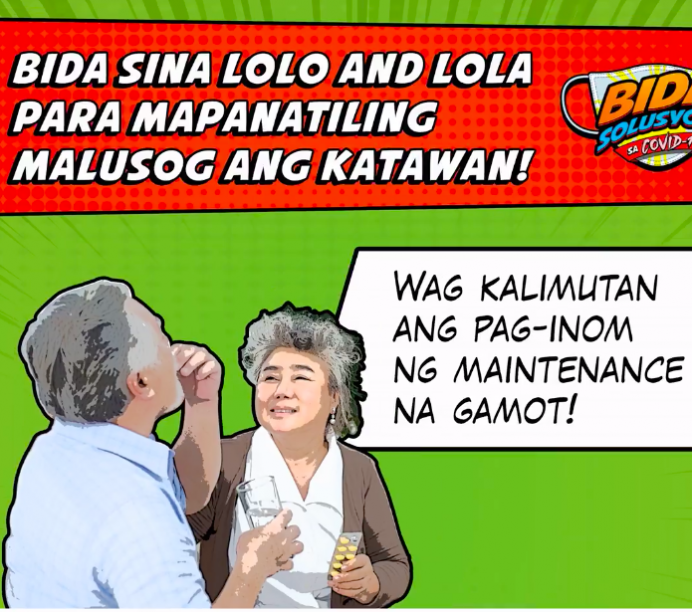Home > Blog > Covid-19
Improving the Info Campaign against COVID-19

Eight months into the quarantine, the pandemic is not the only life-devastating issue Filipinos are dealing with. With Super Typhoon Rolly making landfall in Bicol and CALABARZON last November 1, the National Disaster Risk Reduction and Management Council (NDRRMC) has so far reported 20 deaths and more than 2 million people affected.
A day after the disaster, the Department of Health (DOH) urged local government units (LGUs) to strictly enforce measures and prevent the spread of COVID-19 in evacuation centers. Compounding the problem are the unstable power and water supply in Bicol, and health workers unable to report for work because they, too, have been victimized by the typhoon.
Despite this downpour of risks, the most effective way to empower the public is through clear and constant communication. Awareness, which leads to preparedness and actionable information, helps save lives. With the pandemic redefining the Filipinos’ way of living since the first quarter of the year, has the government’s info campaign against COVID-19 successfully achieved these goals?
To gather insights, Panahon TV sat down with communication veterans—Tony, an executive creative director and managing partner of a Manila-based advertising agency; and April, a freelance creative creator, who formerly taught visual communication at the University of the Philippines Diliman, and also worked as a creative director in an advertising agency.
The Fight against COVID-19 as an Advertising Campaign
Tony shares that an advertising campaign begins with a client brief, which outlines its challenges, objectives and measurement of success. Before creating the campaign, a solid strategy needs to be in place. “The accounts team fleshes out the brief to make it more inspiring for the agency, and to figure out ways of attacking the problem. They profile the target market and come up with the message from the brand’s perspective. The agency’s work is to combine that message with a human story. We create the campaign, and eventually, we produce. So the crucial part is really the creative thinking before the creatives.”
April stresses the importance of seeing the brand through the consumer’s eyes. “You should know what’s already in their minds to influence their thoughts—if there’s a mindset you want to change, if you want them to listen to you for a product sell. Then you ask what you can offer that the other products or services cannot.” After analyzing the target market, a communication plan is formed, outlining the key touch points with the consumer, including the best ways to reach them.
When asked to give a general evaluation of the government’s COVID-19 info campaign, Tony feels that the basic question, What do they really want to say?, is not being addressed. “Everything seems muddled. It’s not clear whom they’re talking to or who’s doing the talking. Who’s the face of the COVID campaign? Is it the DOH secretary? The IATF [Inter-Agency Task Force on Emerging Infectious Diseases]? Or is it the president?” Having different faces for the campaign may lead to information overload, leaving the public confused about what they really need to do.
When the virus entered the country, various LGUs released announcements of their first COVID-19 cases. With inappropriate visual elements, some notices ended up looking more like party invitations than serious declarations. “One of the layouts used is from Canva [an app that provides free graphic design templates],” April observes. “To me, this suggests a mismanagement of funds and the failure to tap the right professionals.”
 LGU’s notice on its area’s COVID-19 cases
LGU’s notice on its area’s COVID-19 cases
On DOH’s Bida Solusyon Campaign
With financial aid from the U.S. Agency for International Development (USAID), DOH launched its “BIDA Solusyon sa COVID-19” campaign last July. Supported by various sectors including top corporations and industries, the campaign promotes these four key preventive steps:
Bawal walang mask.
I-sanitize ang kamay at iwas-hawak sa mga bagay.
Dumistansya ng isang metro.
Alamin ang totoong impormasyon.
A quick look at the campaign’s Facebook page reveals a comics theme, with messages incorporated into brightly-colored panels that feature real-life characters wearing superhero costumes. April and Tony both agree that the messaging is outdated.
“I’d imagine the person who commissioned this to be an old practitioner of advertising—that’s his idea of what a witty campaign is,” comments April. “It relies on mnemonics and catchy phrases, without customizing communication for each message.” She cites an infographic for senior citizens that looked forced since the campaigner insisted on incorporating the comics theme and BIDA tagline. “When that happens, you sacrifice function for form, and you end up not communicating at all. You need to mine your audience’s insight to communicate with them. And because the campaign messages are all the same, people might not bother reading them.”
 (grabbed from the campaign’s Facebook page)
(grabbed from the campaign’s Facebook page)
Though Tony recognizes the campaign’s thrust to empower the public, he feels that its messaging could be more urgent. “It’s an old DOH style from ‘Yosi Kadiri’ days. And I think for COVID, we should stop all of these witty, pa-funny, pa-cute campaigns. You can’t express the gravity of the situation with a campaign like ‘BIDA’.” Tony also points out that the government campaign needs stand out in a sea of public service messages from brands and corporations. “Information should be readily available to the public. It has to be ubiquitous. The problem is that different LGUS make their own campaigns, so the messaging and looks vary. The campaign should be centralized to gain maximum impact.”
Ways to Improve the Campaign
Tony considers fake news and its many forms, such as misinformation and disinformation, as the campaign’s biggest enemy. “Until now, my barber still believes that COVID-19 is a make-believe issue because no one in his barangay has contracted it. How can this be possible eight months into the pandemic?” For April, credible sources of information should be top priority. “If I were to make a brief, I’d make a quick survey to find out what the public needs to know. Then I’d employ scientists to get the hard facts on the virus.”
Carry out the campaign in phases.
“Information should be handled in phases,” says Tony. “Communication shouldn’t stop at any stage. While making information available on various channels, you should add more to it as time goes by.” April states that there should always be access to earlier, accurate information for those belatedly reading up on the virus. “At the same time, you sustain the interest of those knowledgeable with new and more specific information. It’s also important tap the right people— writer, visual communicator, art director, illustrator. So it all starts with good planning, good research, and hiring the right people to do the campaign.”
Customize the campaign.
April stresses that communication channels have different strengths that should be utilized. “It’s not a one-size-fits-all kind of solution. You should customize the messaging for each medium. Some information would sound better on radio; some would work better on social media.” Campaign customization also includes clearly identifying the target audience. “I think what the campaign is trying to do is talk to everyone. And we cannot do this,” says Tony. He believes that the youth isn’t targeted enough. “Young people are agents of change. If the youth is addressed and mobilized, they can achieve a lot of things. The government should do a campaign for schools and involve student leaders.”

BIDA infographic that doesn’t say where to put used face masks (photo grabbed from campaign’s FB page)
Centralize messaging and best practices.
“Why are Pasig, Marikina and Manila doing a better job than the rest of the country?” muses Tony. “It only means that there’s no sharing of best practices. The national government should gather and study these effective measures and institutionalize them.” An effective centralized campaign includes making data more relatable. “We’re always talking about numbers but what do they really mean? If you’re an ordinary guy, you won’t understand why the numbers go up, go down,or plateau. They’re just a bunch of numbers not explained to us.”
Strengthen the government’s image.
“I think one of the problems with the DOH campaign is that some don’t see the government as a credible source of information,” says April. “There were times when the government and scientists from UP [Octa Research] released conflicting information.” Tony agrees. “There’s an advertising quote that says ‘A great ad campaign will make a bad product fail faster.’ Even if you have a brilliant ad campaign, but you have a bad product, it will not sell, but only expose what’s wrong with your product. So even if you have a great campaign, but your infrastructure and processes are not prepared—the campaign won’t be effective.”

